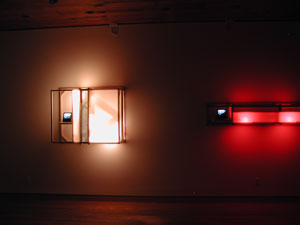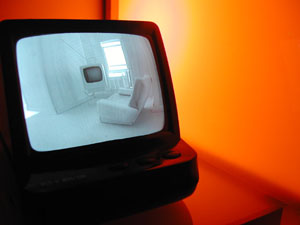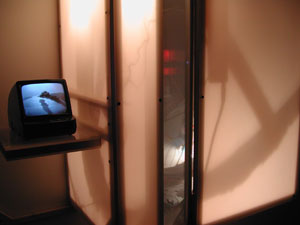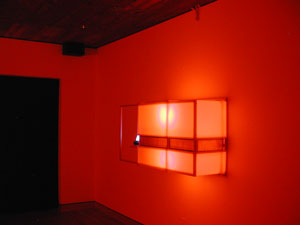Livefeed, an installation by the artists Jeff Shore and John Fisher on view at Houston’s Mixture Gallery, is a fairly complicated installation that combines narrative storytelling, abstract three-dimensional objects, and sound. It succeeds not because it obliges you to figure out the mysteries of its machinery (which it does), but rather because it remains compelling after you have done so.
Viewing Livefeed is actually two experiences. The first involves sitting and watching a black and white video, which presents a series of interiors followed by an aerial view of a landscape. The second experience involves walking through the gallery, watching a group of wall-mounted boxes glow as their inner bits and pieces cast moving shadows.
In fact, the two experiences are linked, as miniature scenes within each box are captured on tiny video cameras. These scenes are then projected on the wall in another room. One box contains a tiny hallway, one a living room, one an airplane interior, and one a miniature landscape. As you see the hallway, the living room, and so forth in the video, each corresponding box is lit from within by a bright white light, while the others glow a soft red or yellow. The video is live — what you see projected on the wall is being recorded at that moment from within one of the sculptures.
Granted, none of this is immediately clear the first time you view Livefeed. I started with the projected video, which took a couple of viewings to memorize its sequence: strange ambient music precedes any image, and then a dim hallway appears on the screen. The camera moves past doors with cracks of light beneath them, towards a door at the end of the hall. Like the children’s closet in Poltergeist, the final door glows most brightly around its edges, and even the floor boards and the walls around it seep light. When the camera reaches the door, the scene shifts abruptly to a white square, which, as the camera pulls back, resolves itself into a TV set in a dingy-looking apartment. The camera floats, ghostlike, around this scene for a moment, then the light goes ominously dim and the TV begins to flicker. The camera returns to the television screen, and the scene shifts abruptly to a white rectangle with rounded corners. This turns out to be a window inside an airplane, and the camera now hovers around an aisle of three chairs. (When I saw Livefeed, two of the chairs had been knocked over, suggesting disaster. It turns out the miniature camera inside the sculpture ran into them — an accident that substantially changed the feel of this segment.) As in the living room, the light inside the airplane goes suddenly dim, lightning flashes outside the windows, and the camera pulls toward the window. Another abrupt scene shift and we are flying over a pastoral landscape. Well-kept fields lined with neat drainage ditches and a chemical plant are the only signs of human occupation. We fly for a while, then return once again to the hallway, where we pull back to our original position.
All of this is accompanied by ambient electronic music that quickens and slows, creating a unique mood in each scene.
The video describes a journey, with key fixtures in each segment acting as portals to the next: the door in the hallway, the television set, the window inside the airplane. The three interiors feel close and a little sinister. The dingy hallway is like that of a run-down hotel, the living room is small and rather squalid. Even the sterile, 60s airplane interior suggests the spaceship in 2001: A Space Odyssey. The hallway implies being trapped in certain inexorable decisions (you take the door at the end because it is the door at the end); the living room suggests experiencing the world (via TV) from a cramped and fusty remove; the airplane is almost a jeering send-up of a kind of Wallpaper magazine chic-travel-for-chic-travel’s-sake. When the camera finally “flies” over the landscape, it is almost a relief to have the wide view — though the cylindrical storage tanks of the chemical factory mitigate any sense of the sublime. Throughout the video, you the viewer are passively journeying through some dreamlike, seedy underbelly of human experience.
Considering its simplicity and the opacity of its narrative, the video is surprisingly engaging. Ultimately, however, the glowing wall-boxes in the other room are the real story.
If the video is a journey, then so (to a certain extent) is the physical experience of walking through the gallery as one is “called” by each sculpture in succession. Watching the boxes do their thing, you are no longer a passive participant but the omniscient witness to a kind of complicated dance. Like backing up from the Solar System to get a sense of what each planet is doing, watching the sculptures in Livefeed light up in sequence gives a kind of satisfying, cosmic picture, and explains just what was going on in the video. Each sculpture has a small scrim “window” through which you can glimpse the miniature scene and tiny camera inside, and attached to each sculpture is a small monitor that plays the video.
The boxes themselves are strangely anthropomorphic. Before the video begins, each piece “introduces” itself, glowing suddenly and accompanied by a solemn chiming noise; after the video finishes, there is a quieting denouement as the sculptures slowly synchronize their glowing color (red), then fade as the music quiets. Fisher’s music has a definite sacred feel — his chords and organ music swell and recede like the Philip Glass score for Koyaanisqatsi. With this cinematic music as immersive backdrop, the boxes glow as a chorus together, take center stage for their individual performances, and recede in unison. The shadows cast by the moving parts within each sculpture have an irresistibly gentle, almost caressing movement — the tiny boom connected to a camera that reaches forward and back, the landscape whose two shadowed edges move independently of each other, one clearly outlined as trees and hills, the other an indistinct, undulating haze.
Shore and Fisher have technically moved way beyond their previous installations. Formerly, they were working out the relationship between the visuals and the music (Shore constructs the objects and is in charge of all machinery; Fisher composes the music and handles the computer programming). In Livefeed, for the first time, the sculptures are a community rather than autonomous units, and the music binds together the two experiences of watching the video and watching the glows and gyrations of the sculptures.
The objects themselves have also become progressively more refined since Shore began making them in 1998. He says of the recent sculptures that using lighting on the inside makes him take more responsibility for the exteriors. He acknowledges that they bear a resemblance to Donald Judd boxes, but points out that when trying to make a minimal box for housing something, the comparison is inevitable. The boxes” sole purpose is to disguise the vignettes inside, so the shape and size is determined by the miniature scene within. For the artist, the nicely-constructed exterior is ultimately just a bonus.
Shore and Fisher have been exploring the idea of information removed from its source for some time. Many of the ideas in Livefeed were worked out during the invasion of Iraq by U.S. troops in April. We visit other countries via television, particularly during wartime. Inspired by this concept, Livefeed takes us on a compelling journey through the psychological landscape in the other room.
All images courtesy the artists and Mixture Gallery.
Rainey Knudson is the founder of Glasstire.






